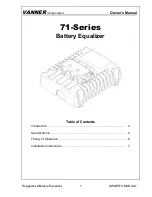
8
TUBE ULTRA-Q T1951
4
The
FREQUENCY
control selects the filters center frequency, which can be freely chosen within the
frequency range of the associated band.
5
The
LEVEL
control determines the amount of level boost/cut. The setting range is from -15 to +15 dB.
6
The
BANDWIDTH
control determines the slope or quality of the filter. Settings from 0.03 (Q = 43) to 2
octaves (Q = 0,67) are possible. A small bandwidth (high Q) means that the only a small portion of the
total frequency range will be affected while a wide bandwidth (low Q) means that a large part will be
affected.
7
With the
SHELF/PEAK
switch the two outer bands can be switched from parametric (peaking
response) EQ to low and high pass (shelving EQ) filters respectively. Use this feature to eliminate
rumble, plop and breathing noises from the bottom end and noise or hiss from the top end. When
switched to PEAK mode the filters operate identical to the other filters.
8
The individual
IN/OUT
switches allow for enabling/disabling specific bands in the audio path. Use this
switch to check the influence of the separate filters and to switch unused filters of for maximum signal
integrity.
Fig. 1.2: Control elements on the front panel
9
The
WARMTH
control determines the amount of harmonics the UTC circuit adds to the signal. This is
the amount of tube sound (WARMTH) that is added.
10
The
WARMTH
meter displays the amount of added harmonics. This controls the amount of harmonics,
or tube sound (WARMTH), the UTC circuit adds to the signal.
11
Use the
POWER
switch to turn the TUBE ULTRA-Q on or off. When switched of the TUBE ULTRA-Q
automatically switches to a hard bypass mode, the signal is then led directly to the outputs.
13
15
14
12
Fig. 1.3: Rear panel elements of the TUBE ULTRA-Q
1. INTRODUCTION
All manuals and user guides at all-guides.com









































